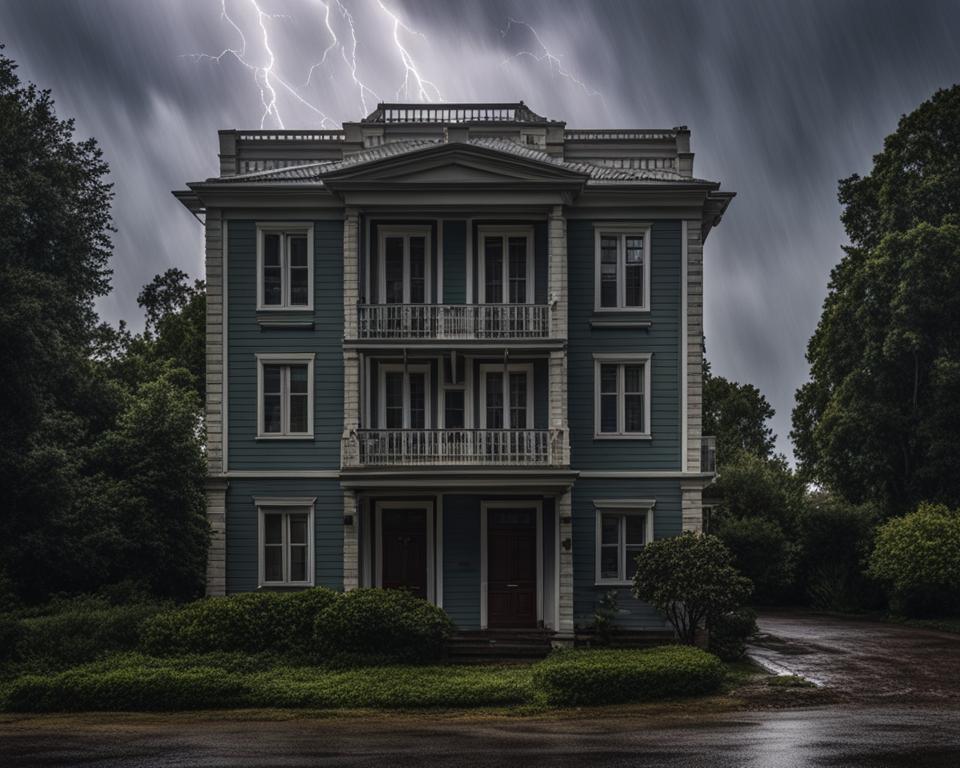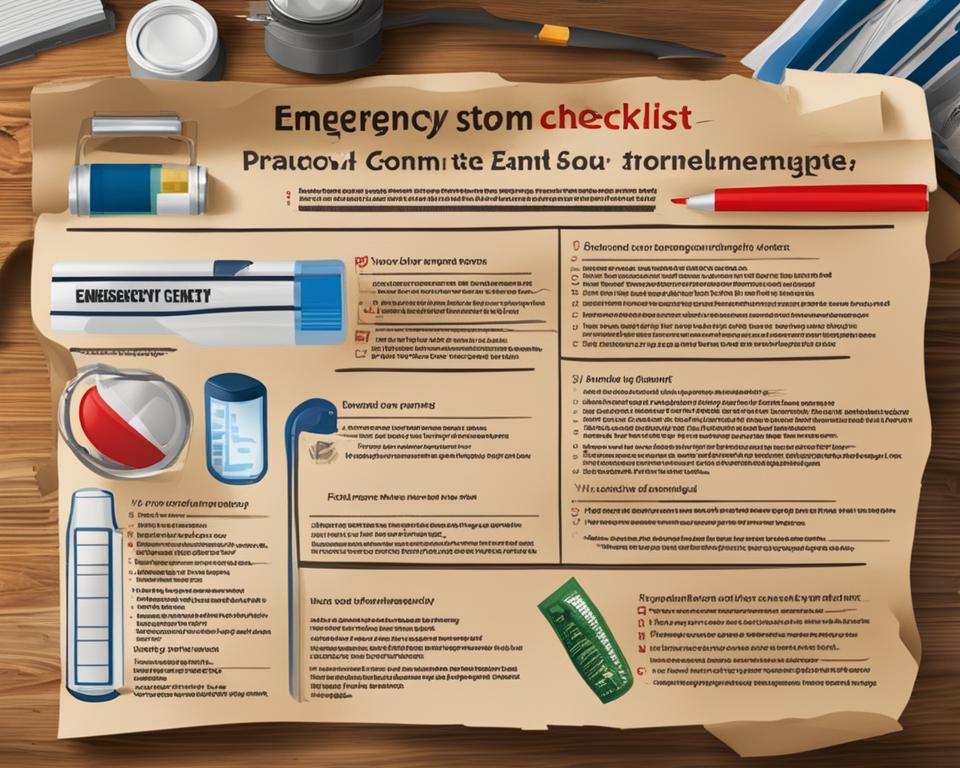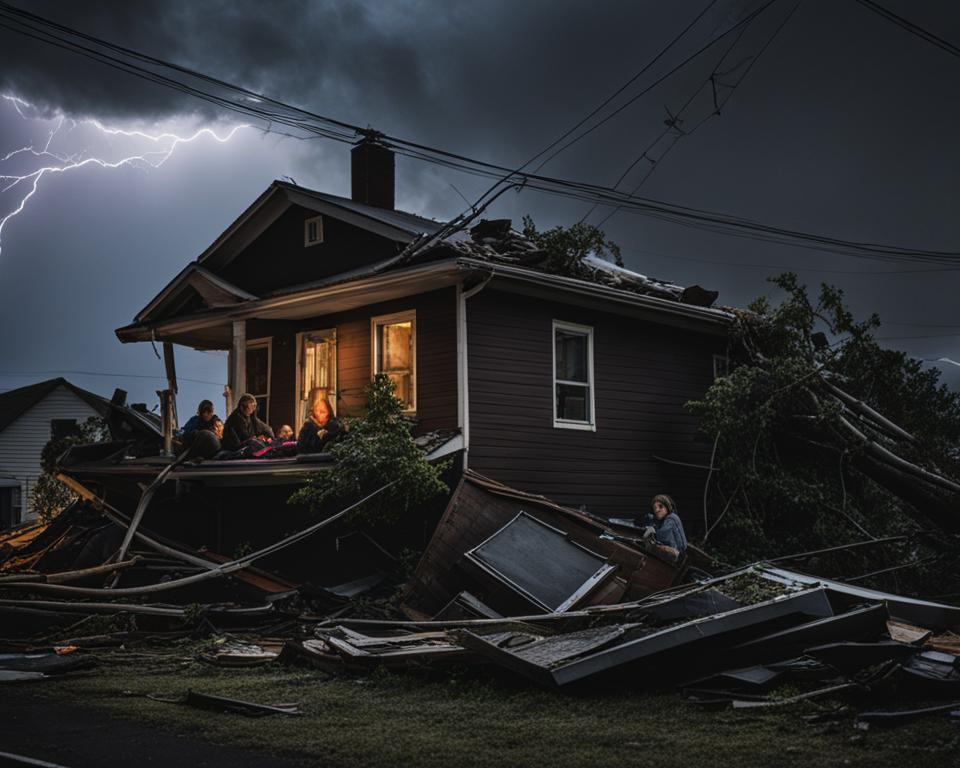Severe storms can cause significant damage and pose risks to individuals and their property. By following these emergency tips for storm damage, you can stay safe and prepared. These tips include staying informed about severe weather warnings, preparing an emergency kit with essential supplies, securing your property before a storm, and having a plan in place for evacuation if necessary.
Key Takeaways:
- Stay informed about severe weather warnings.
- Prepare an emergency kit with essential supplies.
- Secure your property before a storm.
- Have a plan in place for evacuation if necessary.
Identifying Risks and Taking Precautions
Before a storm hits, it’s crucial to identify the potential risks and take necessary precautions to minimize damage and ensure safety. Here are some key tips to consider:
Analyze Your Insurance Coverage
Review your storm damage insurance coverage to ensure that it adequately protects your property and belongings. Check for specific coverage for wind, hail, and other storm-related damages. Consider adding any necessary riders or increasing coverage limits if needed. Familiarize yourself with the claims process and contact your insurance provider for any clarifications or questions.
Secure Loose Objects
Strong winds during a storm can turn loose objects into dangerous projectiles. Take the time to secure or store away any outdoor items that could potentially cause damage. This includes patio furniture, garden tools, toys, and decorations. Ensure that heavy objects are properly anchored, and lightweight items are stored in a secure location.
Trim Trees and Reinforce Windows and Doors
Overhanging branches and weakened tree limbs can easily break off and cause significant damage to your property during a storm. Hire a professional tree service to trim any branches that pose a threat. Additionally, reinforce your windows and doors with impact-resistant materials such as shutters or plywood to reduce the risk of breakage and protect against flying debris.
Know Safe Areas in Your Home
Identify the safest areas in your home where you can take cover during a storm. Basements, storm shelters, or interior rooms on the lower level of your house, away from windows, can provide the most protection. Ensure that these areas are easily accessible and free from clutter. Prepare them with emergency supplies, such as a battery-powered radio, flashlights, first aid kit, and a supply of non-perishable food and water.
| Risks | Precautions |
|---|---|
| Wind damage | Secure loose objects, reinforce windows and doors |
| Tree damage | Trim trees, remove weak branches |
| Flying debris | Secure outdoor items, store lightweight objects |
| Power outages | Have a backup generator or alternative power source |
By taking these precautions, you can minimize the risks associated with storm damage and increase the safety of your property and loved ones. Stay informed about severe weather warnings, follow storm damage safety tips, and be prepared to take immediate action when necessary.
Protecting Your Property
When it comes to storm damage, taking proactive steps to protect your property can make a significant difference in minimizing the impact. By implementing the following measures, you can help safeguard your home and belongings:
Securing Outdoor Items:
- Bring in any outdoor furniture, grills, or other loose objects that could become projectiles during high winds.
- Secure or store items that cannot be brought indoors, such as patio umbrellas and lightweight decorations.
Reinforcing Vulnerable Areas:
- Inspect and reinforce your property’s doors, windows, and garage doors to make them more resistant to strong winds.
- Consider installing storm shutters or using plywood to protect windows from flying debris.
- Ensure all entry points are properly sealed to prevent water damage.
Preparing for Potential Flooding:
- Clear gutters and downspouts of debris to prevent water buildup.
- Elevate valuable items and electrical equipment in lower areas of your home to minimize flood damage.
- Consider installing a sump pump or applying waterproof coatings to basement walls and floors.
Creating a Landscape Maintenance Plan:
- Regularly trim trees and remove dead branches to reduce the risk of them falling onto your property during a storm.
- Securely anchor young or weak trees to mitigate the chances of them being uprooted by strong winds.
By implementing these storm damage prevention measures, you can help protect your property and minimize the potential for costly repairs. However, it’s important to remember that no precaution is foolproof, and having appropriate insurance coverage is crucial for comprehensive protection against storm damage.

Initiating Repairs
Once the immediate danger has passed, it’s crucial to initiate repairs and restoration to restore your property after storm damage. Assessing the extent of the damage is the first step in this process. Take a thorough inventory of the areas affected, documenting any structural damage, water intrusion, or other issues that may require attention. This documentation will be crucial when contacting your insurance company to file a claim.
When it comes to repairing storm damage, it’s often best to hire professionals who specialize in restoration services. These experts have the knowledge, experience, and equipment necessary to address all types of storm damage, from minor repairs to major structural issues. Be sure to research and choose a reputable restoration company that is licensed, insured, and has a solid track record of successful storm damage repairs.
Once you’ve selected a restoration company, they will begin the process of repairing and restoring your property. This may involve repairing structural damage, replacing or repairing damaged materials, drying out water-damaged areas, and eliminating any mold or mildew growth that may have occurred as a result of the storm. They will also work closely with your insurance company to ensure a smooth claims process and maximize your coverage.
| Benefits of Hiring Professionals for Storm Damage Repairs |
|---|
| Expertise in assessing and addressing storm damage |
| Access to specialized equipment and materials |
| Knowledge of building codes and regulations |
| Efficient and timely completion of repairs |
| Coordination with insurance company for seamless claims process |
| Peace of mind knowing the repairs are being handled professionally |
By promptly addressing storm damage and initiating repairs, you can prevent further deterioration of your property and ensure a quicker recovery process. Remember to document all damage, hire reputable professionals, and work closely with your insurance company to maximize your coverage. With the right team and resources, your property will be restored to its pre-storm condition in no time.
Emergency Response to Storm Damage
In the immediate aftermath of a storm, taking swift action is crucial. Having an emergency response plan in place can help ensure the safety of yourself, your loved ones, and your property. Create an emergency storm damage checklist that includes the following essential tasks:
- Check for structural damage: Assess the integrity of your home or building to identify any visible damages or compromised areas that may pose a safety hazard.
- Address immediate safety concerns: Take immediate action to address any potential safety risks, such as turning off utilities if there is a risk of gas leaks or electrical issues.
- Contact relevant authorities and service providers: Inform local emergency services, utility companies, and your insurance provider about the storm damage to initiate the necessary assistance and repairs.
By following an emergency storm damage checklist, you can ensure that all critical aspects are addressed promptly, minimizing the potential for further risks and facilitating a smoother recovery process.

Safety Precautions for Storm Damage
When dealing with storm damage, it is crucial to prioritize safety to prevent injuries and ensure a smooth recovery process. Follow these storm damage safety tips to protect yourself and others during cleanup and restoration:
1. Wear Appropriate Protective Gear
Before starting any cleanup or repair work, make sure to wear the appropriate protective gear. This includes sturdy work gloves, safety goggles, and a dust mask to protect against debris, dust, and potential contaminants.
2. Avoid Contact with Floodwaters and Standing Water
After a storm, floodwaters and standing water can pose significant risks. Avoid coming into contact with these waters, as they may be contaminated and carry pathogens. If you need to remove standing water, use proper equipment, such as a pump or wet vacuum, and make sure to thoroughly disinfect the affected area afterward.
3. Ensure Proper Ventilation
If you need to use generators or other equipment that produces fumes or exhaust, ensure proper ventilation in the area. Carbon monoxide poisoning can be a serious threat, so never operate generators or other fuel-burning equipment indoors or in enclosed spaces.
4. Seek Professional Help for Hazardous Tasks
Certain tasks, such as tree removal or working on damaged electrical systems, can be hazardous. It’s essential to seek professional help for these tasks, as they require specialized knowledge and equipment to be performed safely.
5. Follow Local Authorities’ Instructions
Stay updated on any advisories or instructions issued by local authorities regarding storm damage cleanup and safety. They will provide guidance on areas to avoid, potential hazards, and any specific precautions to take based on the local conditions.
By following these safety precautions, you can minimize the risks associated with storm damage and ensure a safe and efficient recovery process.
Preventing Additional Risks
After a storm, it’s important to take proactive measures to prevent additional risks and further damage to your property. By addressing these potential risks, you can protect your home and ensure a safer living environment.
Checking for Gas Leaks
One of the immediate steps you should take after a storm is to check for gas leaks. Storm damage can cause gas lines to rupture, posing a serious safety hazard. If you smell gas or suspect a leak, evacuate the area immediately and contact your gas provider for assistance. Do not attempt to fix the leak yourself.
Securing Temporary Coverings
If your home has suffered damage to the roof or windows, it’s crucial to secure temporary coverings to prevent further water intrusion and potential structural damage. Use tarps or plywood to cover any exposed areas until permanent repairs can be made. This will help protect your home from additional weather-related damage.
Monitoring for Mold Growth
Excessive moisture and water damage from storms can lead to the growth of mold, which can negatively impact indoor air quality and pose health risks. Keep an eye out for any signs of mold growth, such as a musty odor or visible mold patches on walls or ceilings. If mold is present, it’s important to address the issue promptly by contacting a professional mold remediation service.
Addressing Electrical Issues
Storm damage can cause electrical issues, such as power surges or damaged wiring. If you experience any electrical issues after a storm, such as flickering lights or outlets not working, it’s crucial to address these problems to prevent the risk of electrical fires or further damage. Contact a licensed electrician to assess and repair any electrical issues in your home.
| Preventing Additional Risks Checklist |
|---|
| Check for gas leaks |
| Secure temporary coverings for damaged areas |
| Monitor for mold growth |
| Address electrical issues |
Coping with the Emotional Impact
Recovering from the aftermath of storm damage can be an incredibly difficult and emotionally challenging experience. The devastation caused by severe weather can leave individuals feeling overwhelmed, anxious, and hopeless. It is crucial to acknowledge and address the emotional impact of the disaster in order to begin the healing process.
One of the most important aspects of coping with the emotional impact is seeking support from family, friends, and the community. Talking about your experiences and feelings with loved ones can provide a sense of comfort and understanding. Additionally, support groups and professional counselors can offer specialized guidance and assistance for those struggling with their emotional well-being.
Engaging in stress-relief activities can also be beneficial for emotional healing. This can include participating in hobbies and activities that bring joy and a sense of normalcy back into your life. Exercise, meditation, and spending time in nature are all excellent ways to reduce stress and promote emotional well-being.
Emotional Health Tips:
- Seek support from family, friends, and professionals
- Engage in stress-relief activities such as exercise and meditation
- Join support groups and seek counseling if needed
- Take time for self-care and prioritize your emotional well-being
| Resources for Emotional Support | Contact Information |
|---|---|
| National Suicide Prevention Lifeline | 1-800-273-TALK (1-800-273-8255) |
| Disaster Distress Helpline | 1-800-985-5990 or text “TalkWithUs” to 66746 |
| National Alliance on Mental Illness | 1-800-950-NAMI (1-800-950-6264) |
Resources for Assistance and Support
If you find yourself in need of immediate assistance or support following storm damage, there are organizations available to help you navigate the recovery process. Whether you require financial assistance, shelter information, or other resources, local disaster relief organizations such as the Red Cross can provide the guidance and support you need.
These reputable organizations have extensive experience in assisting individuals and communities affected by natural disasters. They can help you access the resources necessary to begin the recovery journey. From connecting you with financial aid to offering information on available shelters, disaster relief organizations play a vital role in helping you get back on your feet.
It is essential to reach out to these organizations as soon as possible. They can offer valuable advice and support, ensuring you have the necessary assistance to navigate the challenges brought about by storm damage. Remember that you are not alone in this process and that help is available.
FAQ
What should I do to prepare for a severe storm?
Stay informed about severe weather warnings, prepare an emergency kit with essential supplies, secure your property, and have an evacuation plan in place if necessary.
How can I protect my property before a storm?
Identify potential risks, review your insurance coverage, secure loose objects, trim trees, reinforce windows and doors, and know the safest areas of your home to take cover.
What steps should I take to minimize storm damage?
Secure outdoor items, reinforce vulnerable areas of your home, consider storm shutters or plywood for windows, and bring in loose objects before the storm.
What should I do after a storm?
Conduct a thorough storm damage cleanup, remove debris, dry out water-damaged areas, and contact professionals if necessary for structural damage assessment and repairs.
How can I initiate repairs after a storm?
Assess the extent of the damage, hire professionals for repairs and restoration, contact your insurance company, and document the damage for insurance claims.
What should I include in my emergency storm damage checklist?
Check for structural damage, address immediate safety concerns, turn off utilities if necessary, and contact relevant authorities and service providers.
How can I ensure my safety during storm damage cleanup?
Wear appropriate protective gear, avoid contact with floodwaters and standing water, ensure proper ventilation when using generators, and seek professional help for hazardous tasks.
How can I prevent additional risks after a storm?
Check for gas leaks, secure temporary coverings for damaged roofs or windows, monitor for mold growth, and address any electrical issues.
How can I cope with the emotional impact of storm damage?
Seek support from family and friends, engage in stress-relief activities, and reach out to professional counselors or support groups if needed.
Where can I find assistance and support after storm damage?
Contact local disaster relief organizations such as the Red Cross for financial assistance, shelter information, and other resources.

Leave a Reply